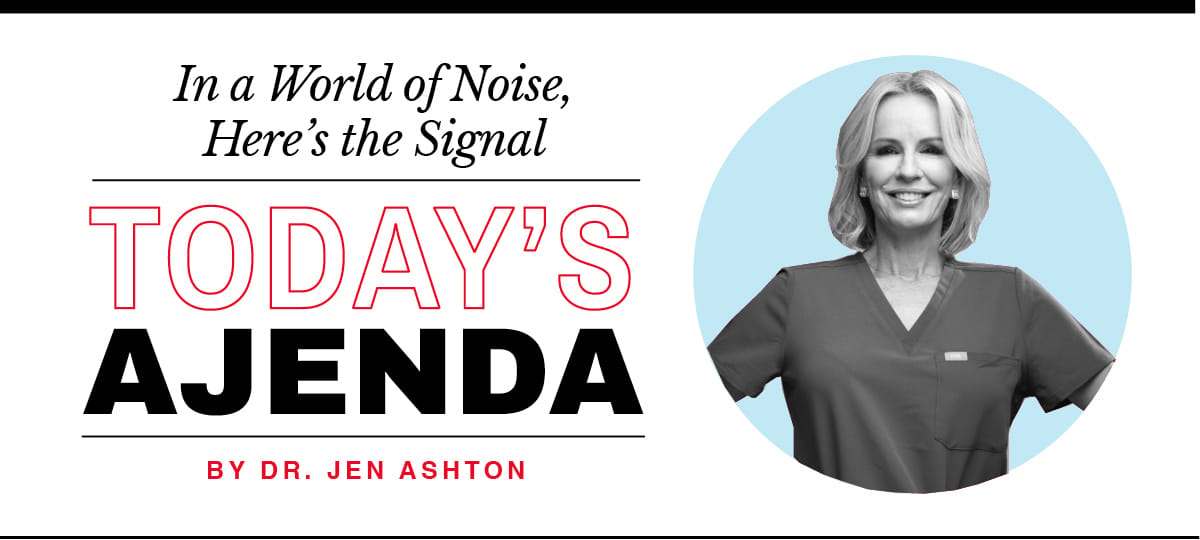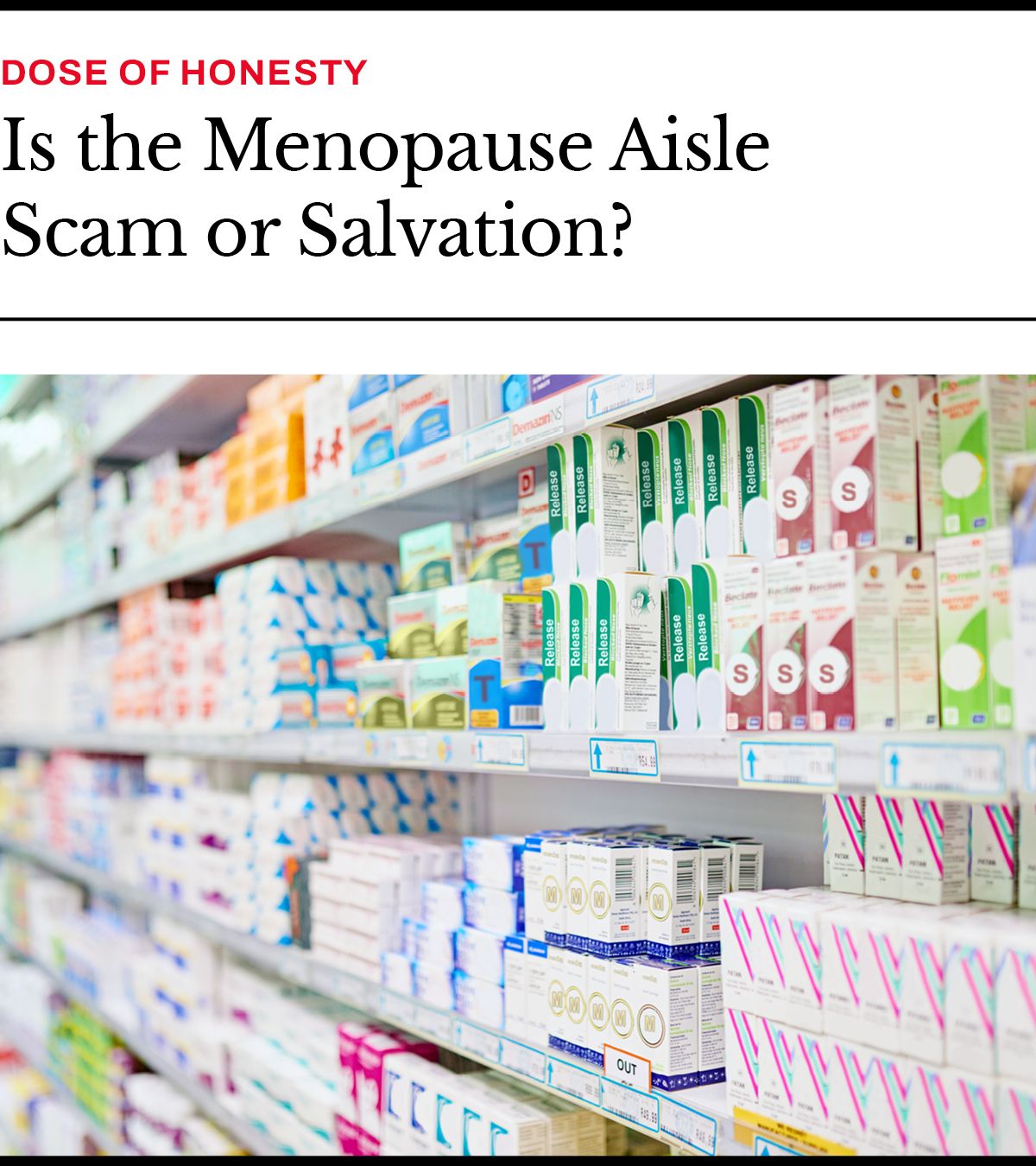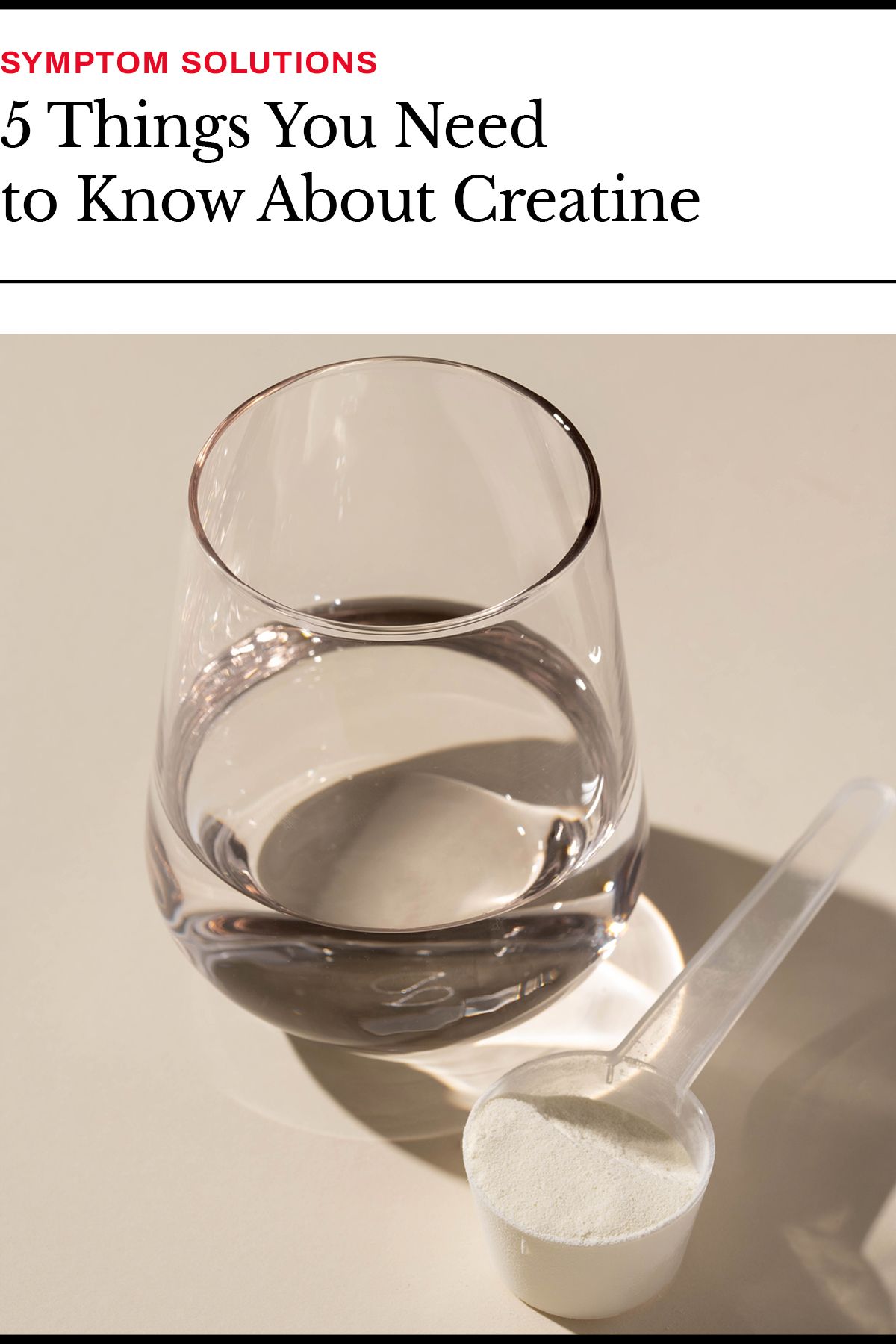- Today's Ajenda
- Posts
- TODAY'S AJENDA #85
TODAY'S AJENDA #85
Welcome to TODAY'S AJENDA!


The “menopause aisle” didn’t even exist 20 years ago. Now, you’ll find shelf after shelf of gummies, teas, creams, and supplements in your local Walgreens or Target promising relief.
But do any of them actually help?
Maybe you’re thinking: “It should, right? They’re selling it.” But menopause is big business, with the global market projected to reach $24.35 billion by 2030. That kind of money attracts innovation and phony opportunists looking for their cut.
Most of the time? The treatments that bring real relief come from a prescription (and not an OTC supplement).
Let’s go over the most effective prescription options, and then we’ll see if anything in the menopause aisle is worth your money.
The Prescriptions
Hormone Therapy
This is the most effective treatment we have for hot flashes and night sweats, especially if you’re within 10 years of menopause. Both UK and US medical guidelines confirm this based on decades of evidence.
Non-hormal Brain-Targeted Medicines
Can’t do hormones or don’t want to? There are newer alternatives. The FDA approved fezolinetant in 2023, the first, 100% hormone-free, NK3 receptor blocker for moderate to severe hot flashes and night sweats due to menopause. Elinzanetant followed in 2025.
The Retail Options
Supplements
I’d be wary of supplements. They look official, but they don’t need FDA approval before being sold. The FDA only steps in after problems are reported.
Also, a supplement labeled “for menopause” may be identical to a general women’s supplement. It’s not uncommon for manufacturers to slap the word “menopause” to try to capitalize on the menopause movement that is sweeping the globe.
This doesn’t mean that there aren’t or can’t one day be a supplement that can really help support women in menopause, it’s just that many today don’t or aren’t any different than those for women NOT in menopause.
Botanicals
Botanicals aren’t much better. One of the more popular ones is black cohosh, which is heavily marketed for hot flashes.
Science Says: A 2023 review of 22 studies of products containing black cohosh found they were potentially beneficial for menopause symptoms.
However, more trials are needed. And like all botanicals, without third-party testing, you can't be certain what's actually in the bottle or at what dose.
If You Still Want to Try OTC Options
Here’s my Rx:
1) Target specific symptoms.
Natural cooking oils like coconut oil or olive oil are better for vaginal dryness and painful sex than OTC sex lubes. Cooling bedding and breathable sleepwear can help you sleep through minor hot flashes.
Doctor’s Note: Keep in mind that these products address symptoms, not the root cause.
2) Verify what you’re buying.
If you’re buying supplements or botanicals, always look for third-party testing from labs like NSF or USP. And avoid “proprietary blends” as they hide exact doses.
3) Loop in your doctor.
Tell them every medication you’re on. Supplements can interact with antidepressants, anticoagulants, and other prescriptions.
That’s my advice if you’re going the OTC route, but prescriptions are almost always more effective. So is the menopause aisle salvation or a scam?
Neither. Some products can offer comfort, but they won't resolve menopause itself. The heavy hitters are still hormone therapy (which is what I take personally) and FDA-approved non-hormonal medicines.
The good news? You have options available, and the right treatment plan can make all the difference.

Creatine is everywhere. But it’s been monopolized by the young, male, muscle-obsessed crowd. What most people don’t realize is that women over 50 stand to gain just as much from creatine as a 20-something dude doing bicep curls in his garage (if not more!).
As a dietician, I’ve learned many surprising things about creatine. Here are five you should know:
1) Creatine can help you think clearly.
Creatine isn’t just for building muscles. It can also improve your memory and cognitive function.
A 2021 study of 1,340 adults aged 60+ found that higher creatine intake was linked to better scores on cognitive tests and may help prevent age-related decline in brain function.
A 2022 systematic review found that creatine supplementation significantly improved memory performance in older adults (66-76 years).
2) Creatine helps offset what menopause takes away.
Estrogen helps your muscles produce creatine. When it drops during menopause, so do your muscle creatine levels (cue the fatigue, reduced strength, and sluggish recovery).
Creatine supplementation can counteract this. It won’t replace estrogen, but it restores energy and provides muscle support. I personally take creatine almost every day, and so does my husband.
3) You can have creatine with coffee.
There’s a myth that caffeine “cancels out” creatine. The idea came from a small 1996 study that suggested caffeine interfered with creatine’s effects on muscle relaxation. But more recent trials show they co-exist just fine.
Fun Fact: A 2015 review found that creatine and caffeine work differently. Creatine improves power for short bursts (e.g., resistance training or sprinting) while caffeine shines for endurance (e.g., long run or cycling).
4) Not all creatine is created equal.
There are different types of creatine, but only one is backed by hundreds of peer-reviewed studies: creatine monohydrate. It’s the gold standard for muscle and cognitive benefits.
Bonus: Creatine monohydrate doesn’t require you to do a “loading phase” (taking high doses for the first week) or to “cycle off” (taking breaks).
People always ask me which brand I use. I actually just covered this in last week’s issue of my new newsletter, Off Duty with Dr. Jen. Subscribe below to see which product made the cut and get my frank, friend to friend, rundown on what I’m using, what I’m reading, and what I’m focusing on:
5) Food gives you creatine, but not enough.
Creatine is in animal proteins like beef, salmon, and chicken. But even generous portions fall short of the research-backed dose of 3-5 grams daily.
For example: A half-pound (8 oz) steak provides just 2 grams of creatine.
That means you’d have to eat about a pound of meat every day to reach the advised dose. And if you’re vegan or vegetarian? Chances are, your baseline creatine stores are even lower.
So, to get the doses proven effective in studies, supplementation is your only real option.
Tips on Taking Creatine
If you’re looking to hop on the creatine bandwagon, just be sure to choose third-party tested creatine monohydrate and run it by your doctor first. Start slow and low dose, and gradually increase to 5 grams a day over 1-2 weeks. (And if you drink it with coffee, be sure to hydrate! 🚰)
What do you think is cleaner: indoor air or outdoor air?
Most people would vote for indoor air. Right? It’s a controlled environment, with no car exhaust or pollen storms. But indoor air can actually be 2-5x more polluted than what’s outside.
And when your air is that dirty? Two things could happen:
Your skin takes a hit. Various airborne particles, some not visible to the naked eye, could be present in your home, which may clog your pores and trigger inflammation.
Your sleep suffers. Inhaling larger particles may leave you with a scratchy throat or congestion that could disrupt your rest.
This is where air purification steps in. I like Canopy’s Bedside Air Purifier,* which traps up to 99.97%** ultra-fine particles, like dust, pollen, pet odors, and more, to support your wellbeing and skin with its HEPA-grade filter.
I consider Canopy’s Bedside Air Purifier part of my bedroom, which I try to optimize as much as possible. Beyond air filtration, it has a built-in aroma diffuser, white noise, and a red night light that can really elevate the quality of my sleep.
The Canopy team was kind enough to offer the Ajenda community early access to their Black Friday sale with 20% off site-wide before anyone else, with the code JENAIR20!
If you’re curious about tweaking the environment of your sleep den towards a possible better night’s sleep and clearer skin, now’s the time, before the depths of winter really take hold.
Note: The code expires Wednesday, November 12.

Fiber can help you lose weight, feed good gut bacteria, stabilize blood sugar, and even support your body during menopause. But despite these benefits, most American women aren't eating enough of it:
Zoom In: People eat an average of 10 to 15 grams of fiber a day. Women over 50 should be getting at least 22 grams of fiber daily.
When it comes to weight loss specifically, fiber really shines. A study of 240 adults with metabolic syndrome (high blood pressure and excess belly fat) compared two approaches: the complete American Heart Association (AHA) diet versus simply eating more fiber.
After 12 months? The fiber group lost 4.6 pounds while the AHA group lost 6. This means that one simple diet shift (eating more fiber) was almost as effective for weight loss as a multi-component diet.
But what’s really amazing to me about fiber isn’t about weight: It’s how it helps your body handle menopause.
Fiber, Meet Menopause
Here’s how fiber helps us navigate the chaos of menopause:
First: Fiber feeds estrobolome (gut bacteria that regulate estrogen). These bacteria influence how much estrogen gets reabsorbed into your body versus flushed out.
During menopause, when estrogen levels drop, eating enough fiber helps keep those bacteria in balance so your body can use estrogen more effectively.
Second: After menopause, your body stores fat differently and becomes less sensitive to insulin. This makes the appetite feel “louder” and portions creep up.
Fiber fights back by slowing digestion, stabilizing blood sugar, and making you feel fuller. Studies consistently show that people who eat more fiber lose more weight and stick with it longer.
Personally, I love that because it gives you a positive assignment (eat more fiber!) instead of a list of restrictions. I would rather ‘add’ than ‘subtract.’
What Most People Don’t Know About Fiber
1) There are two main types of fiber.
Soluble fiber dissolves in water and slows digestion. Insoluble fiber doesn’t dissolve and instead adds bulk to stool and keeps things moving along.
Luckily, there’s no need to plan a complicated grocery haul to get both types of fiber. Many foods already have both!
2) Foods beat supplements.
Whole foods deliver both types of fiber plus vitamins, minerals, and other nutrients. Supplements give you isolated fiber in a pill so you miss out on all that extra good stuff. Get fiber from actual food whenever possible. I turn to fiber powders when I am in a hurry, know I am falling short of my daily fiber target, or both.
3) Start slow or pay the price.
Jumping from 10-15 grams of fiber to 25-30 grams will leave you bloated and gassy. Your gut bacteria need time to adjust to the new menu. Increase fiber gradually and drink lots of water.
How to Hit 30 Grams of Fiber Daily
Start strong at breakfast.
Get 10 grams early, and the rest of the day gets easier. Try ½ cup oats with chia, flax seeds, Greek yogurt with berries, or a veggie omelet with a slice of whole-grain toast and avocado.
Add vegetables to every meal.
Think two fists of produce per meal, however you like them: raw, roasted, or sautéed. Just get them in. I’m a fan of dark leafy greens like kale, which also gives a boost in calcium.
Choose whole grains.
Choose oatmeal, barley, bulgur, brown or wild rice, whole-wheat pasta, or whole-grain bread. If the first ingredient is “whole wheat” or “whole oats,” you’re in good shape.
Fiber (or any nutrient for that matter) isn’t a magic bullet. Weight loss still requires healthy habits like resistance training, balanced meals, and consistency. That’s exactly what we focus on in The Wellness Experiment: a practical and science-backed approach towards helping you become the happiest and healthiest version of yourself.

Did you enjoy Today’s Ajenda? It would mean the world if you left us a testimonial!

ABOUT DR. JEN
In her former roles as chief medical correspondent for ABC News and on-air cohost of “GMA3: What You Need to Know,” Dr. Jennifer Ashton—”Dr. Jen”—has shared the latest health news and information with millions of viewers nationwide. As an OB-GYN, nutritionist, and board-certified obesity medicine specialist, she is passionate about promoting optimal health for “the whole woman.” She has authored several books, including the national best-seller, The Self-Care Solution: A Year of Becoming Happier, Healthier & Fitter—One Month at a Time. And she has gone through menopause…
Forwarded this email?

Missed the last issue?

Want a copy of Dr. Jen’s best-selling book?
*Note: This newsletter includes affiliate links. Sponsors may earn a commission if you purchase.
** As small as 0.3 microns. Tested to ISO 29463 standards.

This material is provided solely for informational purposes and is not providing or undertaking to provide any medical, nutritional, behavioral or other advice or recommendation in or by virtue of this material. This newsletter is for general informational purposes only and does not constitute the practice of medicine, nursing or other professional health care services, including the giving of medical advice, and no doctor/patient relationship is formed. The use of information on this newsletter or materials linked from this newsletter is at the user’s own risk. The content of this newsletter is not intended to be a substitute for professional medical advice, diagnosis, or treatment. Users should not disregard, or delay in obtaining, medical advice for any medical condition they may have, and should seek the assistance of their health care professionals for any such conditions.








